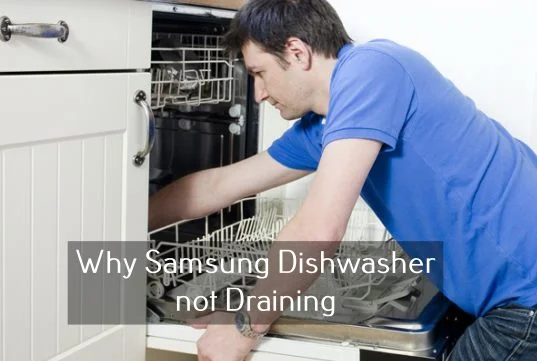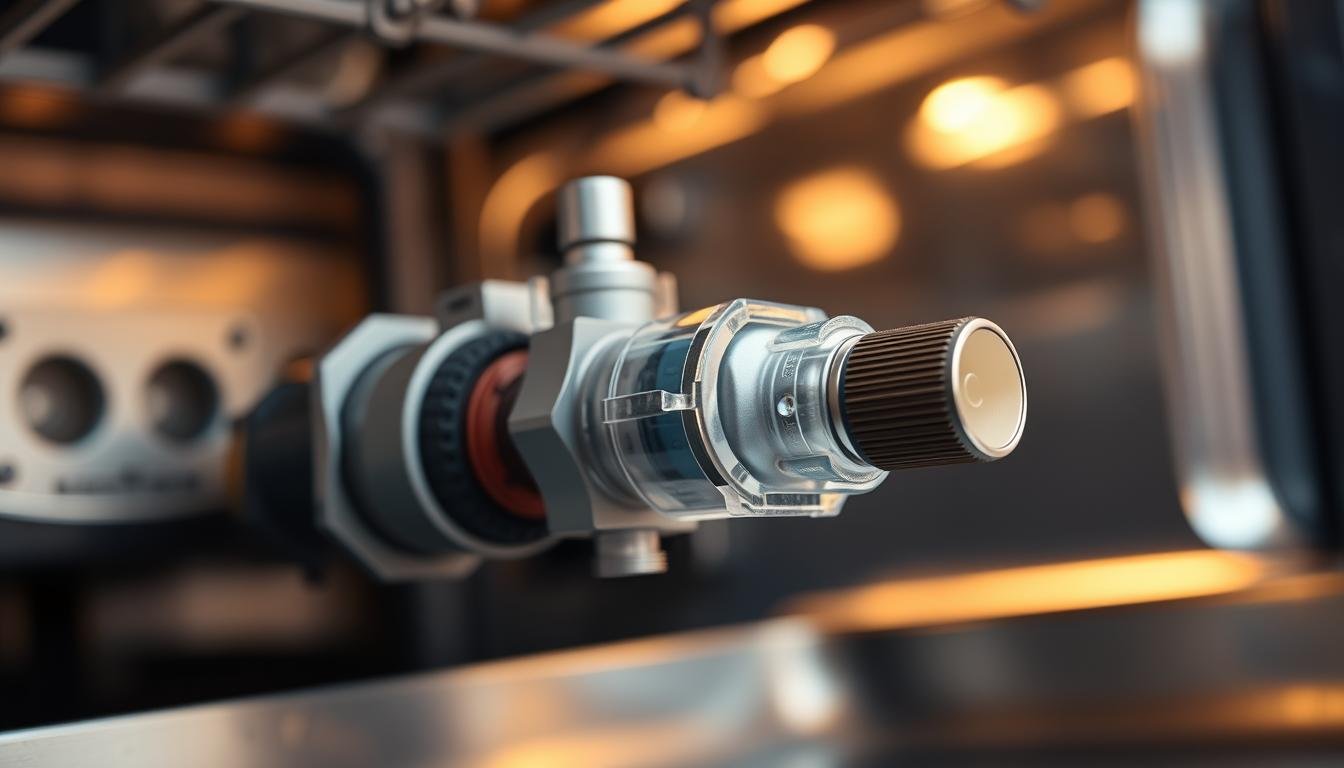Are you tired of your Samsung dishwasher staying full of water after a cycle? A Samsung dishwasher not draining can make cleaning up a real challenge. Standing water can cause mold, bad smells, and even damage your appliance.
I’ve helped many homeowners solve Samsung appliance problems. In this guide, I’ll show you how to fix Samsung drainage issues fast and well. You’ll learn how to clean filters and even do pump repairs. This will help your dishwasher work like new again.

Get ready to become your own appliance repair expert. Say goodbye to those stubborn drainage problems!
Understanding Common Samsung Dishwasher Draining Issues
Having a Samsung dishwasher that won’t drain can be really frustrating. Knowing how your dishwasher’s drainage system works is key to fixing problems fast. Let’s explore the main parts and common issues that might stop your dishwasher from draining right.
Your Samsung dishwasher’s drainage system is made up of many parts working together. When something goes wrong, it can make a simple wash cycle a big problem.
Key Drainage System Components
- Drain Pump: Responsible for pushing water out of the dishwasher
- Drain Hose: Connects the dishwasher to the sink or garbage disposal
- Filter System: Catches food particles and prevents clogs
- Check Valve: Prevents water from flowing back into the dishwasher
Common Drainage Error Codes
| Error Code | Meaning | Potential Cause |
|---|---|---|
| 5C | Drainage Problem | Blocked drain hose or filter |
| 5E | Drain Sensor Issue | Faulty water level sensor |
| OE | Drain Overflow | Clogged drainage system |
| OC | Control Board Problem | Electrical drainage system failure |
Initial Troubleshooting Steps
- Check the sink drain for blockages
- Inspect the dishwasher’s drain hose connection
- Clean the dishwasher filter
- Verify the garbage disposal knockout plug is removed
Knowing about these drainage problems can save you a lot of time and money. Spotting the signs early can help avoid bigger issues with your Samsung dishwasher’s draining system.
Read also: Remove the Broken Glass in Garbage Disposal
Samsung Dishwasher Not Draining: Primary Causes and Solutions
When your Samsung dishwasher stops draining, several issues might be the cause. Knowing why your dishwasher won’t drain can save you time and stress. Let’s look at the most common problems that stop water from draining.
- Clogged Drain Filter: Food particles and debris often block the filter, stopping water flow.
- Damaged Drain Hose: A clogged drain hose can block water from draining.
- Pump Assembly Malfunction: Problems with the internal pump can also stop water from draining.
Now, let’s dive into why your Samsung dishwasher might not be draining:
| Problem Area | Potential Cause | Recommended Action |
|---|---|---|
| Drain Filter | Food particle buildup | Clean or replace filter |
| Drain Hose | Kinks or blockages | Inspect and clear hose |
| Drain Pump | Mechanical failure | Check pump functionality |
The most common reasons for Samsung dishwasher drainage problems are a blocked filter or drain hose. I suggest checking these first before looking at more complex fixes. A simple clean might fix your problem quickly.
Some issues need a pro, like if the drain pump or internal parts are damaged. If basic checks don’t work, call a Samsung appliance repair expert.
How to Check and Clean the Dishwasher Filter System
A clogged dishwasher filter can make cleaning up a real hassle. I’ll show you how to find, take out, and clean your Samsung dishwasher filter. This will help with drainage and keep your dishwasher working well.
It’s important to keep your dishwasher filter clean to avoid drainage problems. Dirt, food bits, and other debris can build up. This can block your dishwasher and make it less efficient.
Finding Your Dishwasher Filter
Most Samsung dishwashers have filters at the bottom. They’re usually found near the base, in spots like:
- Bottom center of the dishwasher tub
- Near the spray arm
- Behind the lower rack
Step-by-Step Filter Removal Process
- Take out the bottom dishwasher rack
- Find the filter assembly
- Twist the filter counterclockwise to unlock
- Gently pull the filter out of its housing
Dishwasher Cleaning Tips for Filter Maintenance
When cleaning your filter, use these tips to get rid of grime and buildup:
- Rinse the filter under warm running water
- Use a soft brush for tough spots
- Avoid harsh chemicals or abrasive sponges
- Check for damage while cleaning
Reassembly and Final Checks
After cleaning, put the filter back by aligning it and twisting clockwise until it clicks. Make sure it’s sealed well to avoid future problems.
| Cleaning Frequency | Recommended Action |
|---|---|
| Monthly | Routine filter cleaning |
| Every 3-6 months | Comprehensive filter inspection |
| Annually | Professional maintenance check |
By following these steps, you’ll keep your Samsung dishwasher running smoothly. This will prevent drainage issues caused by a clogged filter.
Examining the Drain Hose for Blockages and Damage

When your Samsung dishwasher isn’t draining right, the drain hose is often to blame. Let’s go over how to check and fix any problems with the drain hose.
A clogged drain hose can block your dishwasher’s drainage. Look closely at the entire drain hose for signs of trouble. Check for:
- Visible kinks or bends restricting water flow
- Accumulated debris or food particles
- Cracks or physical damage to the hose
- Loose connections at sink or dishwasher connections
To really check the drain hose, take it off and do a simple test. Remove the hose and look inside for blockages. Use a flashlight to spot any issues that might block water flow.
| Drain Hose Condition | Recommended Action |
|---|---|
| Minor Kinks | Straighten and reposition |
| Moderate Blockage | Clean with mild detergent and water |
| Significant Damage | Replace drain hose completely |
If you find a clogged drain hose, don’t worry. Most problems can be fixed with a good clean or by replacing it. Make sure the hose has a high loop or air gap. This helps prevent backflow and keeps drainage working well.
Proper Installation of Air Gap and High Loop Methods
Keeping your dishwasher drain hose in good shape is key to avoiding water backup and ensuring it works well. When setting up your Samsung dishwasher, you have two main choices: the air gap or the high loop method.
The air gap and high loop methods are vital in stopping wastewater from going back into your dishwasher. They act as a barrier, keeping your appliance safe from harmful contaminants.
Understanding Air Gap Functionality
An air gap is a small, cylindrical device usually placed on your sink or countertop. Its main job is:
- Creating a physical break in the drain line
- Stopping water from flowing back
- Keeping your dishwasher safe from contamination
High Loop Installation Requirements
If an air gap isn’t possible, the high loop method is a good alternative. Here’s how to set it up:
- Attach the drain hose under your sink
- Create a high loop using zip ties or mounting brackets
- Secure the loop at least 32 inches above the floor
- Make sure the loop is higher than the sink’s drain point
Installing either method correctly will greatly reduce drainage problems. It will also protect your Samsung dishwasher from water damage.
Investigating Drain Pump Problems and Solutions
Dealing with drain pump issues in your dishwasher can be challenging. Most problems fall into two main areas: mechanical failures and electrical malfunctions.
Mechanical issues often involve a broken or damaged impeller. This prevents water from being pumped out effectively. Such problems can make draining water a big challenge for your Samsung dishwasher.
- Check for unusual grinding or humming sounds
- Look for visible damage to the pump mechanism
- Inspect the impeller for signs of wear or breakage
To test the drain pump’s electrical function, you’ll need a multimeter. It’s important to check the pump’s continuity. A healthy drain pump should show a resistance reading around 200 ohms.
| Pump Condition | Multimeter Reading | Recommended Action |
|---|---|---|
| Normal Functioning | 200-250 ohms | No immediate replacement needed |
| Low Resistance | Below 150 ohms | Consider pump replacement |
| No Continuity | 0 ohms | Contact Samsung customer support |
While some DIY fans can tackle simple repairs, complex issues might need a pro. If you’re unsure about the repair, don’t hesitate to contact Samsung customer support.
How to Clean and Maintain the Check Valve (Flapper)
The check valve, or flapper, is key in your Samsung dishwasher’s drainage system. It stops wastewater from going back into your dishwasher. This keeps your dishwasher clean and working well. Knowing how to care for this part can stop draining problems and make your dishwasher last longer.
Identifying Flapper Malfunction
It’s important to know when the check valve is not working right. Look out for these signs:
- Standing water in the dishwasher bottom
- Slow or incomplete drainage
- Unusual gurgling sounds during the drain cycle
- Visible debris around the valve area
Cleaning and Replacement Guidelines
Here’s how to take care of the check valve:
- Unplug the dishwasher for safety
- Find the check valve near the drain pump
- Check for debris or damage
| Maintenance Action | When to Do It | Expected Outcome |
|---|---|---|
| Cleaning | Minor debris or buildup | Restore normal drainage |
| Replacement | Visible damage or persistent issues | Resolve severe drainage problems |
If you face tough Samsung dishwasher draining problems, get help from a pro. Regular upkeep can avoid expensive fixes and keep your dishwasher running smoothly.
Troubleshooting Solenoid Valve Issues
When fixing Samsung dishwasher drainage problems, the solenoid valve is key. This small part controls water flow and can cause big drainage issues if it fails.

Identifying solenoid valve problems in Samsung appliances needs careful checking. The valve can fail due to electrical issues, temperature changes, or mechanical wear. Look for these signs of valve trouble:
- Inconsistent water drainage
- Unusual clicking sounds during cycle
- Complete halt in water movement
- Visible corrosion or mineral buildup
To find a faulty solenoid valve, use a multimeter for electrical tests. Here’s how to do it:
- Disconnect the dishwasher’s power
- Find the solenoid valve (usually near the water inlet)
- Remove the electrical connections
- Set the multimeter to resistance/ohms mode
- Check for the right resistance reading
| Symptom | Possible Cause | Recommended Action |
|---|---|---|
| No resistance | Electrical failure | Replace solenoid valve |
| Inconsistent readings | Partial electrical damage | Professional inspection recommended |
| Visible damage | Physical deterioration | Immediate replacement required |
Fixing Samsung drainage problems can get tricky. While some can replace the solenoid valve themselves, complex electrical work often needs a pro.
Maintenance Tips to Prevent Future Drainage Problems
To keep your Samsung dishwasher in top shape, you need to take care of it. I’ll share some key tips for cleaning and maintenance. These will help avoid drainage problems and make your dishwasher last longer.
Starting with regular cleaning is key to avoiding drainage issues. Keeping up with maintenance can greatly lower the chance of clogs and problems with how it works.
Creating an Effective Cleaning Schedule
- Perform weekly filter cleaning to prevent debris buildup
- Run an empty cycle with white vinegar monthly
- Inspect dishwasher drain hose maintenance quarterly
- Check and clean spray arms every six months
Best Practices for Daily Use
Using your dishwasher right every day can really help it work better. Here are some tips for keeping the drain hose in good shape and caring for your dishwasher:
- Scrape dishes before loading to minimize food debris
- Avoid overloading the dishwasher
- Use recommended detergent amounts
- Run hot water in the sink before starting the dishwasher
Read also: Hot Water Pressure Low but Cold Fine?
| Maintenance Task | Frequency | Purpose |
|---|---|---|
| Filter Cleaning | Weekly | Remove trapped food particles |
| Vinegar Cycle | Monthly | Eliminate mineral buildup |
| Drain Hose Inspection | Quarterly | Prevent possible blockages |
By sticking to these cleaning and maintenance tips, you’ll make sure your dishwasher works its best. You’ll also avoid most drainage problems before they get serious.
Conclusion
We’ve looked into Samsung dishwasher not draining issues and found ways to fix them. Knowing how your appliance works is important for solving problems.
From checking filters to looking at drain pumps, we’ve covered a lot. These steps help keep your dishwasher working well. They can also save you money by avoiding costly repairs.
Regular upkeep is the best way to avoid drainage problems. By following the tips in this guide, your Samsung dishwasher will last longer. Stay on top of maintenance to avoid kitchen headaches.
If you can’t fix it yourself, it’s okay to ask for help. Sometimes, you need a pro to fix complex issues. Don’t be afraid to reach out to Samsung support or a certified technician.


